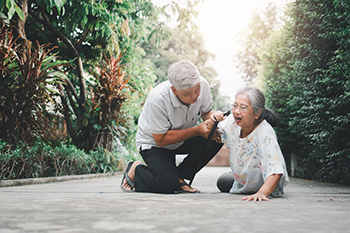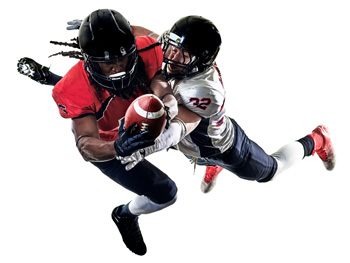283 St Rose Ave
Windsor, ON N8S 1X1
August 2022
Walking and Other Tips for Elderly Foot Care

Maintaining the health of one’s feet is important for everyone, regardless of their age. However, it is especially important for senior citizens, who tend to lose their natural fat cushioning and muscle strength in the feet. There are a number of tips that seniors might consider following to look after the health of their feet. First, you could consider taking walks regularly. Although this may seem simple, walking is one of the easiest ways to strengthen and exercise the feet. Walking can give seniors the full range of motion in the feet needed to keep the feet strong and agile. As an added bonus, walking can additionally improve circulation to one’s feet, helping blood flow throughout the feet and lower legs. Second, you can regularly examine your feet. If a senior can identify any cuts, calluses, or other abnormalities early enough, they might be able to prevent a larger complication down the road. If a senior is unable to examine their own feet, a loved one or care provider might be able to perform these examinations. If you are a senior, don’t take the health of your feet for granted –see a podiatrist today.
Proper foot care is something many older adults forget to consider. If you have any concerns about your feet and ankles, contact the practitioners from Foot Care Institute. Our practitioners can provide the care you need to keep you pain-free and on your feet.
The Elderly and Their Feet
As we age we start to notice many changes in our body, but the elder population may not notice them right away. Medical conditions may prevent the elderly to take notice of their foot health right away. Poor vision is a lead contributor to not taking action for the elderly.
Common Conditions
- Neuropathy – can reduce feeling in the feet and can hide many life-threatening medical conditions.
- Reduced flexibility – prevents the ability of proper toenail trimming, and foot cleaning. If left untreated, it may lead to further medical issues.
- Foot sores – amongst the older population can be serious before they are discovered. Some of the problematic conditions they may face are:
- Gouging toenails affecting nearby toe
- Shoes that don’t fit properly
- Pressure sores
- Loss of circulation in legs & feet
- Edema & swelling of feet and ankles
Susceptible Infections
Diabetes and poor circulation can cause general loss of sensitivity over the years, turning a simple cut into a serious issue.
If you have any questions please feel free to contact our office located in Windsor, ON . We offer the newest diagnostic and treatment technologies for all your foot and ankle needs.
Ways Seniors Can Help Prevent Falls

As a person ages, the chance of falling increases along with the repercussions. Some serious dangers that may result from a fall include a broken hip, a broken wrist, or a head injury. Since the bones are thinner and more brittle, healing can take longer. A fall may also affect a senior’s ability to live alone as well as cause chronic pain and depression. A few ways that seniors can prevent falls are by keeping the body active, having their eyes checked for vision problems, and reviewing medications for side effects. In addition, safeguarding the home by removing loose rugs, installing handrails, and improving lighting in hallways or bedrooms is recommended. Other ways to prevent falls are to install grab bars in bathrooms and use a walker or cane for balance. Wearing shoes with non-skid soles can keep you from slipping or sliding on a polished floor. Foot and ankle symptoms like numbness, tingling, and swelling can contribute to a loss of balance or stability. Please visit a podiatrist for foot and ankle strengthening exercises, as well as other information on how to protect yourself from a fall.
Preventing falls among the elderly is very important. If you are older and have fallen or fear that you are prone to falling, consult with the practitioners from Foot Care Institute. Our practitioners will assess your condition and provide you with quality advice and care.
Every 11 seconds, an elderly American is being treated in an emergency room for a fall related injury. Falls are the leading cause of head and hip injuries for those 65 and older. Due to decreases in strength, balance, senses, and lack of awareness, elderly persons are very susceptible to falling. Thankfully, there are a number of things older persons can do to prevent falls.
How to Prevent Falls
Some effective methods that older persons can do to prevent falls include:
- Enrolling in strength and balance exercise program to increase balance and strength
- Periodically having your sight and hearing checked
- Discuss any medications you have with a doctor to see if it increases the risk of falling
- Clearing the house of falling hazards and installing devices like grab bars and railings
- Utilizing a walker or cane
- Wearing shoes that provide good support and cushioning
- Talking to family members about falling and increasing awareness
Falling can be a traumatic and embarrassing experience for elderly persons; this can make them less willing to leave the house, and less willing to talk to someone about their fears of falling. Doing such things, however, will increase the likelihood of tripping or losing one’s balance. Knowing the causes of falling and how to prevent them is the best way to mitigate the risk of serious injury.
If you have any questions, please feel free to contact our office located in Windsor, ON . We offer the newest diagnostic and treatment technologies for all your foot care needs.
Common Foot Injuries Among American Football Players

With any sport, there is risk of injury while training or playing. This is true for American football as well. The four most common foot injuries among football players are an Achilles tendon rupture, turf toe, a Jones fracture, and plantar fasciitis. An Achilles rupture often happens to football players who train intensively after a period of inactivity, such as at the start of a new season. Achilles tendonitis is inflammation of the tendon located at the back of the foot above the heel, but a rupture is more serious and involves a partial or complete tear. Turf toe is a sprain of the big toe joint. Football players are continually pushing off the ground from the toes, and overextension of the big toe joint can result. This is especially common when playing on artificial turf because of its gripping nature. A Jones fracture is also called a 5th metatarsal fracture. The 5th metatarsal is the long bone that runs on the outside of the foot that connects to the baby toe. It can break from sudden impact, a poor landing, repeated stress, or overuse. This injury can recur if not healed properly. The stud or cleat under a football boot can cause swelling of the tissue that runs under the foot, known as plantar fasciitis. These injuries might be prevented by warming up well, increasing training slowly, wearing supportive football boots, and possibly adding sports inserts. If you or your loved one plays football and has sustained a foot injury, see a podiatrist who can offer a proper diagnosis and treatment options.
Ankle and foot injuries are common among athletes and in many sports. They can be caused by several problems and may be potentially serious. If you are feeling pain or think you were injured in a sporting event or when exercising, consult with the practitioners from Foot Care Institute. Our practitioners will assess your condition and provide you with quality foot and ankle treatment.
Common Injuries
The most common injuries that occur in sporting activities include:
- Achilles Tendonitis
- Achilles Tendon Rupture
- Ankle Sprains
- Broken Foot
- Plantar Fasciitis
- Stress Fractures
- Turf Toe
Symptoms
Symptoms vary depending upon the injury and in some cases, there may be no symptoms at all. However, in most cases, some form of symptom is experienced. Pain, aching, burning, bruising, tenderness, tightness or stiffness, sensation loss, difficulty moving, and swelling are the most common symptoms.
Treatment
Just as symptoms vary depending upon the injury, so do treatment options. A common treatment method is known as the RICE method. This method involves rest, applying ice, compression and elevating the afflicted foot or ankle. If the injury appears to be more serious, surgery might be required, such as arthroscopic or reconstructive surgery. Lastly, rehabilitation or therapy might be needed to gain full functionality in the afflicted area. Any discomfort experienced by an athlete must be evaluated by a licensed, reputable medical professional.
If you have any questions, please feel free to contact our office located in Windsor, ON . We offer the newest diagnostic and treatment technologies for all your foot care needs.
Running Tips for Beginners

It is easy to take running for granted. After all, we learned to run at an early age with little or no training. But as an adult, taking up running for fitness, as a sport, or even as a challenge, requires training and taking precautions. Running a 10K, for instance, can cause a great deal of pain and possible injury if you are not prepared. The following are a few ways to keep your feet and body safe when you take up running. First, get a pair of running shoes that fit properly and provide the cushioning needed to protect your feet from injury. Find socks that wick sweat and help prevent blisters. Tend to any blisters carefully, seeking help from a podiatrist if necessary. Embark on a training plan that begins slowly and builds gradually in time, distance, and speed. Train consistently, rather than leaving long gaps between runs. Make sure you eat healthy foods, boosting the carbohydrates before a run to give you the fuel you will need. Drink lots of water to avoid becoming dehydrated. Pay attention to calluses and corns that may form. It is suggested to check with a podiatrist to see if they can be prevented with orthotics. Podiatrists can also help to address any other toe, foot, or ankle problems that may have developed.
All runners should take extra precaution when trying to avoid injury. If you have any concerns about your feet, contact the practitioners of Foot Care Institute. Our practitioners will treat your foot and ankle needs.
How to Prevent Running Injuries
There are a lot of mistakes a runner can make prior to a workout that can induce injury. A lot of athletes tend to overstretch before running, instead of saving those workouts for a post-run routine. Deep lunges and hand-to-toe hamstring pulls should be performed after a workout instead of during a warmup. Another common mistake is jumping into an intense routine before your body is physically prepared for it. You should try to ease your way into long-distance running instead of forcing yourself to rush into it.
More Tips for Preventing Injury
- Incorporate Strength Training into Workouts - This will help improve the body’s overall athleticism
- Improve and Maintain Your Flexibility – Stretching everyday will help improve overall performance
- “Warm Up” Before Running and “Cool Down” Afterward – A warm up of 5-10 minutes helps get rid of lactic acid in the muscles and prevents delayed muscle soreness
- Cross-Training is Crucial
- Wear Proper Running Shoes
- Have a Formal Gait Analysis – Poor biomechanics can easily cause injury
If you have any questions, please feel free to contact our office located in Windsor, ON . We offer the newest diagnostic and treatment technologies for all your foot care needs.
Gout Pain Can Be Managed
Signs of Ankle Sprains and Strains

It can be difficult to determine whether an ankle injury is a sprain or a strain, because the symptoms are similar. Common to both strains and sprains are ankle pain, swelling, and instability. However, differences in the location of the pain and its side effects can help to indicate whether a muscle or a ligament is the cause. A strain occurs when the muscles and/or tendons in the ankle joint are stretched or torn, usually as a result of overuse. In a sprain, however, the ligaments in the affected area are torn or stretched beyond their normal range of motion. With a sprain, intense pain followed by swelling will be experienced at the site of the injury. A popping sound is likely to be heard. Bruising at the site may also occur, and there is likely to be a decrease in mobility. With a strain, the pain may be acute or appear gradually. Muscle cramps, spasms, and general weakness are common. If you are experiencing any of the above symptoms, it is wise to consult a podiatrist for a complete exam and diagnosis because ignoring the condition could lead to chronic ankle problems.
Ankle sprains are common but need immediate attention. If you need your feet checked, contact the practitioners from Foot Care Institute. Our practitioners can provide the care you need to keep you pain-free and on your feet.
How Does an Ankle Sprain Occur?
Ankle sprains take place when the ligaments in your ankle are torn or stretched beyond their limits. There are multiple ways that the ankle can become injured, including twisting or rolling over onto your ankle, putting undue stress on it, or causing trauma to the ankle itself.
What Are the Symptoms?
- Mild to moderate bruising
- Limited mobility
- Swelling
- Discoloration of the skin (depending on severity)
Preventing a Sprain
- Wearing appropriate shoes for the occasion
- Stretching before exercises and sports
- Knowing your limits
Treatment of a Sprain
Treatment of a sprain depends on the severity. Many times, people are told to rest and remain off their feet completely, while others are given an air cast. If the sprain is very severe, surgery may be required.
If you have suffered an ankle sprain previously, you may want to consider additional support such as a brace and regular exercises to strengthen the ankle.
If you have any questions please feel free to contact our office located in Windsor, ON . We offer the newest diagnostic and treatment technologies for all your foot and ankle needs.









